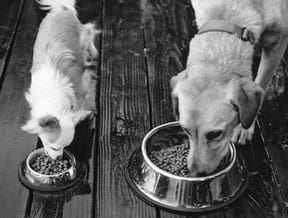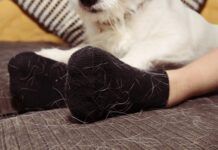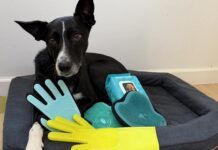Consider your dog’s dinnerware, a topic more complicated than you might have thought.
A visit to your local pet superstore, for example, will reveal dozens of choices, in plastic, stainless steel, glass, nylon, ceramic, and possibly aluminum. Among them are many simple, practical and economical models, meant for long-term everyday use, which are the focus of this article.

Of course, bowls also come in a million different “specialty” models – to feed automatically, repel ants, resist spilling, fold up for travel, and so on. But in essence, dog bowls function in pretty much the same manner: they hold food or water. You can spend a few dollars on a practical stainless steel model, or a few hundred for a kidney-shaped granite job with legs. What’s most important, however, is not what they look like or how much they cost, but whether they contain that food and water without contaminating it with any chemicals of their own!
Many people are unaware that certain types of dog dishes (and people dishes!) are capable of leaching dangerous substances into the foods and liquids that fill them. Concerns have been emerging for some time, for instance, about the use of aluminum cookware, and the possibility of lead poisoning from unsafe pottery glazes. Some experts believe that carcinogenic substances can seep out of plastic dishes, too.
But there are so many attractive, inexpensive, and perfectly safe products on the market – including products made for humans – that there is really no reason to take a chance with your dogs. After all, they might use the same dishes day-in and day-out throughout their lifetimes.
Purpose-Built Dog Food Bowls
If you’re like many dog owners, you feed and water your dog in dishes culled from your own supply of culinary containers. Recently, after visiting the kitchens of a number of dog owners, WDJ came home with some interesting data: most used vessels unintended for the purpose. Some of the dishes were perfectly safe, but we also found among these ad hoc substitutions a cheap aluminum two-quart pot, a chipped glass bowl, a variety of plastics, and a pretty (but possibly dangerous) ceramic dish purchased in a Mexican street market. In every case, we were told those dishes were “temporary situations” whose permanent solutions hadn’t yet made it to the top of the agenda.
We have no problem with using safe “people” dishes, even permanently, but think about it! Using cast-off dishes that aren’t safe for people is even less safe for our dogs, who may be exposed to far more toxins in their short lives than we are!
NOT RECOMMENDED:
Foreign-Made or Old Ceramic Dishes
There are a lot of pretty bowls in the world, and some that are painted and sold for use by dogs are too cute for words. But if you don’t know how or where they were made, it’s best not to use them.
The reason is that ceramic glazes contain lead, which can leach into food and water. Lead is a highly potent toxin that accumulates in the body – once in, it can not be gotten rid of easily or inexpensively. Prevention is the only realistic “cure” for lead poisoning.
Exposure to lead can cause a multitude of health problems, including brain and organ damage, impaired vision and hearing, stunted growth, impaired motor function, cancer, and reproductive complications. The smaller the dog, the more this toxicity is magnified.
In the U.S., manufacturers have been required since 1971 to fire pottery at temperatures high enough (in theory) to make glazing safe – that is, impervious to surface degradation. However, the FDA tests only a small percentage of imported pottery. In reality, a consumer has no way of knowing whether a dish was fired at temperatures adequate to prevent seepage. While the only way to know for sure that a dish will not leach lead is to have it tested, the following cautions should be observed:
• Use only stoneware or porcelain products, both of which are fired at extremely high temperatures.
• Not many people feed their dogs on old, fine china, but if you do – stop! These heirlooms were made before lead was recognized as a hazard.
• Use only those ceramics, foreign or otherwise, which are certified safe. It is important to note, however, that repeated washing and scrubbing can cause glazes to deteriorate; again, this seems to be most common with earthenware, not with properly fired stoneware of porcelain. If a dish’s glaze is corroded, or develops a dusty, chalky gray residue after washing, stop using it at once! The residue is characteristic of a faulty glaze, and it could be very dangerous.
• Avoid dishes with raised decorations on the interior surfaces of the dish. Glazes might not cover all of a textured surface.
• If you suspect your dog has been exposed to lead, ask your veterinarian for a blood test immediately. Chelation therapy can diminish the amount of lead your dog has already accumulated, though the procedure is expensive and difficult. Alternatively, a veterinarian may prescribe a course of action to reduce its effects. For instance, nutritional deficiencies can exacerbate lead poisoning, so a dog that has been exposed to lead would benefit from regular vitamin and mineral supplementation.
• If you are sentimentally attached to ceramic pet dish of questionable origin, you can have it tested at a laboratory, though this can cost anywhere between $35 and $80. Or, you can use a home-test kit. LeadCheck Swabs are available for about $8. Note that these swabs don’t test whether lead is present in the dish, but whether lead is leaching from the dish at the time of testing.
ALSO NOT RECOMMENDED:
Aluminum Dishes
Aluminum is a neurotoxin that can cause cognitive dysfunction and bone damage. Studies have shown that aluminum migrates or leaches into food, though exactly how much is a matter of dispute. Anodized aluminum, as used in high-quality expensive cookware, is thought to lessen or eliminate this interaction with food; this too is a matter of dispute. However, pet dishes made of aluminum are not anodized.
Plastic Dishes
Plastics used in food storage and preparation are an increasingly controversial topic. Plastics can contain a number of substances, such as formaldehyde, chlorine, and resins known to be carcinogenic (cancer-causing). Among these are polyvinyl chloride and polyethylene, which have been shown to migrate into food at high temperatures, such as those produced by microwave ovens.
To prevent this, don’t use plastic dishes if you are in the habit of warming your dog’s food in a microwave, or if you pour very hot water over his kibble a few minutes prior to serving it to him.
If your dog is apt to chew on plastic, or has ever gnawed on the edge of his plastic bowl, you should probably replace his dinnerware with something he can’t chew. Even if the chemicals in the plastic prove to be harmless, ingesting chunks of sharp-edged plastic could be fatal.
Dirty Dishes
These come in every size, color, and description, and they can be as dangerous as any carcinogen. Unless you routinely wash (with hot water and detergent) and thoroughly air-dry your dog’s food and water dish, these containers may provide an ideal site for the growth of harmful bacteria, which can cause mild or severe gastrointestinal upset and even lethal food poisoning.
As far as the food bowl goes, this risk is not great if you feed your dog nothing but dry kibble every day, but it is magnified greatly if you feed your dog raw meats and table scraps. In that case, you MUST wash his bowls daily to prevent harmful bacteria from gaining a foothold in your kitchen. It is wise to rotate water bowls, so one can air-dry while another is in use. Bacteria doesn’t grow in the absence of moisture.
So, look at your dog’s bowls. Are they covered with bits and chunks of old food? Coated with a greasy film? Is there slime growing in the water bowl? . . . Has your dog’s stomach been upset lately?
WDJ RECOMMENDATIONS:
Stainless Steel
Stainless steel, without doubt, is the number one choice of most professional dog breeders and handlers. It is safe, inexpensive, comes in a variety of sizes and shapes, and is also extremely durable and easy to clean. Stainless steel does not interact with food or water, and dogs can’t chew on it. Most pet stores and pet supply catalogs sell stainless steel dishes in a wide variety of sizes, for less than $15.
Glass
This material is a very minor player in the dog bowl trade. We include it because all of us sometimes feed and water our pets with whatever is handy, and if you must use a cast-off, glass is one of the kitchen’s safest materials – as long as it is not cracked or chipped. (If you were in the habit of licking your bowls as clean as dogs do, you’d understand.) From personal experience, however, I must add that any breakable dish that is regularly left on a kitchen floor will get broken. Call it Govier’s Law, if you will – just don’t call my dogs late for dinner.
Roger Govier is a freelance writer. He lives in San Francisco with two mixed-breed dogs.





